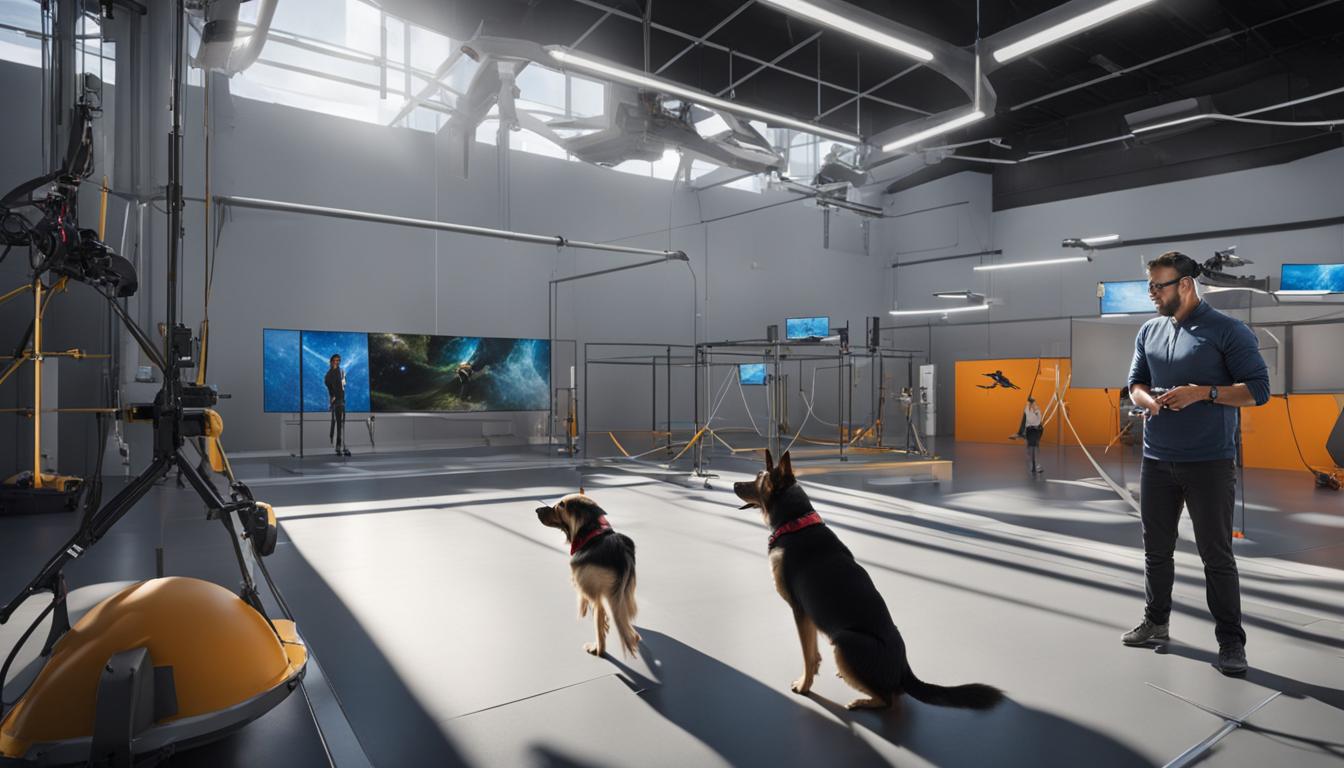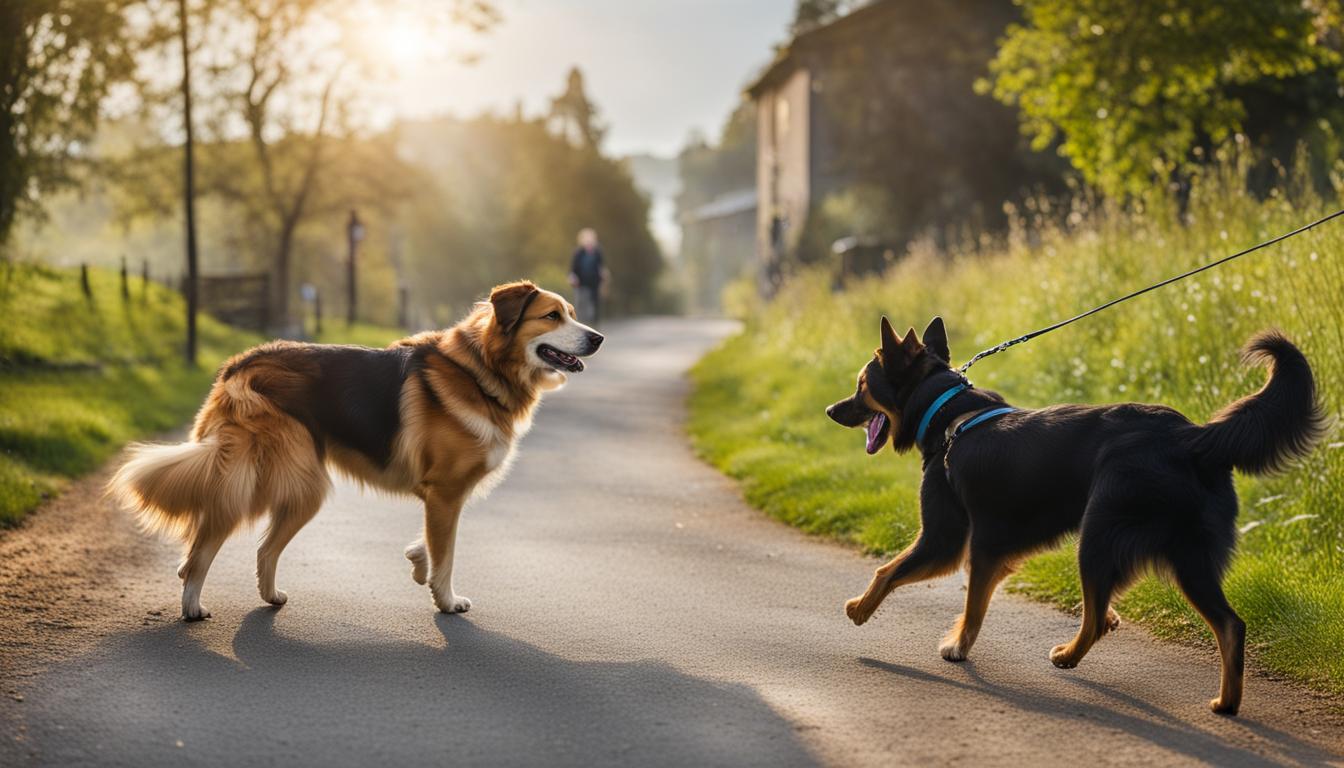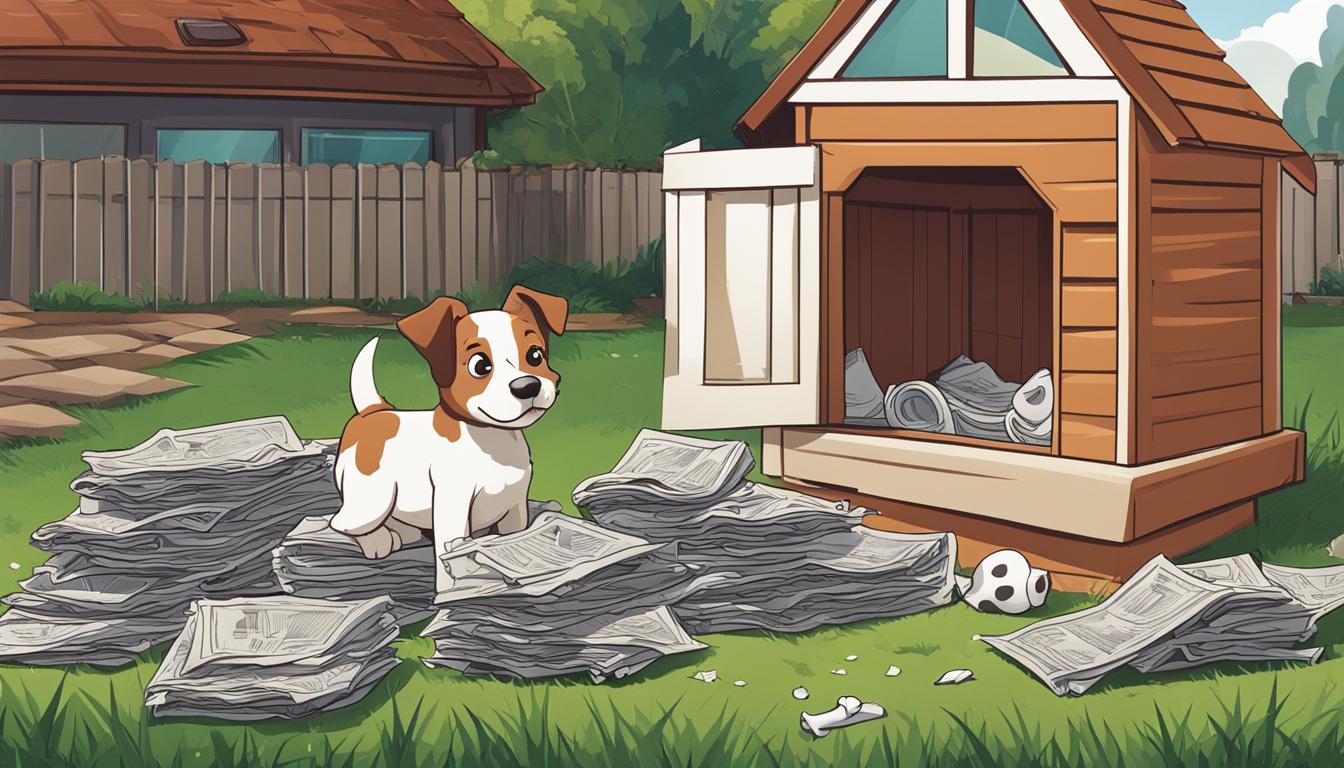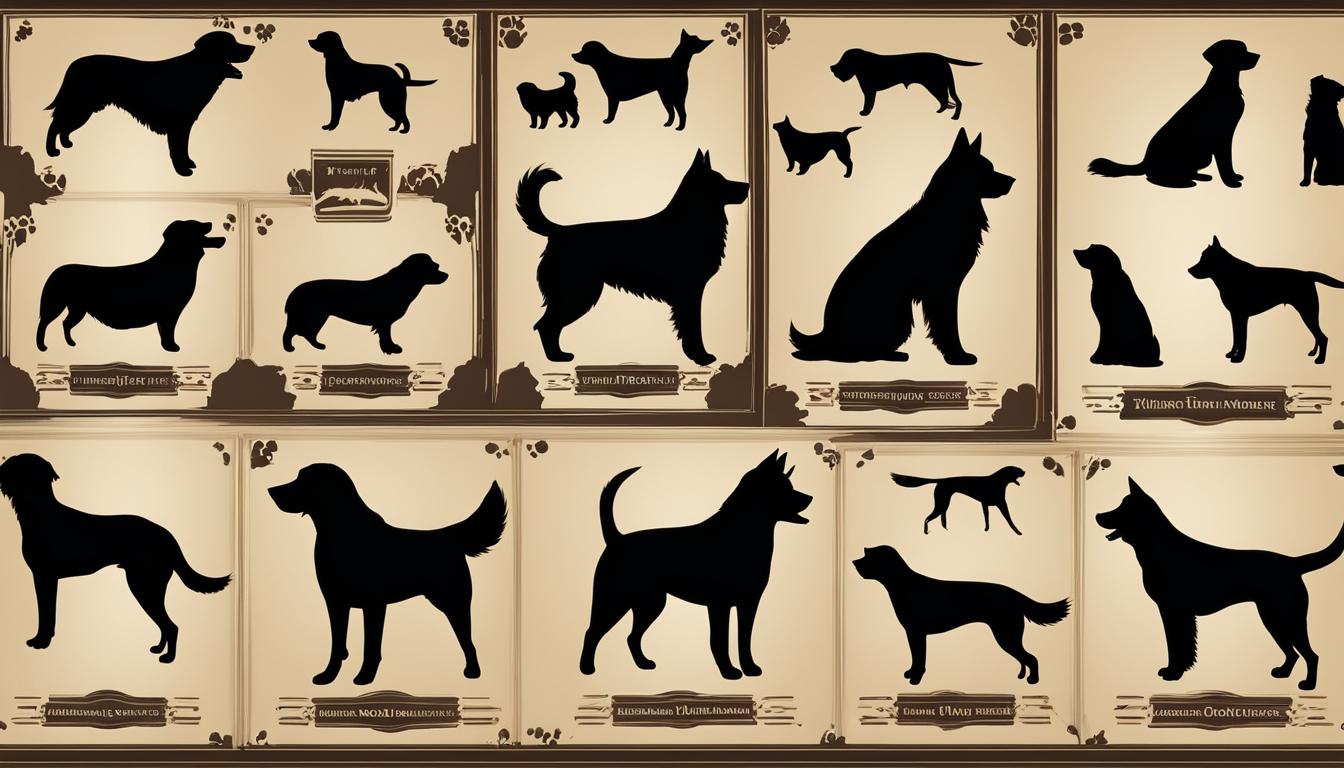Are you struggling with your dog’s jumping behavior? Jumping up can be dangerous and bothersome, but there are effective solutions to help you address this issue. In this article, we will explore research-based techniques to discourage jumping in dogs and provide behavioral training tips. Say goodbye to those flying paws and hello to polite greetings!
Key Takeaways:
- Jumping up is a common behavior problem in dogs that can be addressed through training.
- Avoid dominance theories and outdated punishment methods. Instead, focus on positive reinforcement techniques.
- Withhold attention when your dog jumps and reward them when they keep all four paws on the ground.
- Consistent training and involving friends and family can help curb jumping behavior in dogs.
- Establish yourself as the alpha dog through consistent training and recognition of good behavior.
Understanding Why Dogs Jump Up and How to Stop It
Dogs are known for their enthusiastic greetings, often accompanied by jumping up and down. While it may seem like an adorable display of excitement, jumping can pose several challenges for dog owners. Understanding why dogs jump and implementing appropriate training exercises can help curb this behavior and ensure a more polite and controlled interaction with your furry friend.
So, why do dogs jump up in the first place? Dogs primarily jump up to seek attention and greet people. They consider any form of attention, including negative reactions, as a reward. It’s crucial to withhold attention when your dog jumps and reward them only when all four paws are on the ground. Consistency is key in teaching them that jumping is an undesirable behavior.
There are several effective techniques to discourage jumping in dogs. One approach is to turn your back or remove yourself from the situation when your dog jumps. This sends a clear message that jumping does not result in attention or interaction. Additionally, using treats as positive reinforcement can be highly effective. Rewarding your dog when they keep all four paws on the ground reinforces the desired behavior and motivates them to repeat it.
By incorporating these training exercises into your routine and remaining consistent, you can help your dog understand that jumping is not an appropriate way to greet people. Remember to involve family and friends in the training process to ensure consistency across different interactions. With patience and positive reinforcement, you can successfully curb jumping behavior and promote polite greetings with your furry companion.

Effective Techniques to Discourage Jumping Behavior:
- Withhold attention when your dog jumps
- Turn your back or remove yourself from the situation
- Use treats as positive reinforcement for keeping all four paws on the ground
- Involve family and friends in the training process for consistency
“The best way to teach a dog not to jump is to reward them for keeping all four paws on the ground and withhold attention when they jump.”
By following these techniques and remaining consistent in your training approach, you can effectively address jumping behavior in dogs. Remember to reinforce positive behaviors, avoid punishment, and be patient with your furry friend. With time and dedication, you can enjoy a well-behaved dog that greets people politely and keeps all four paws firmly on the ground.
General Tips and Techniques to Curb Jumping Behavior
When it comes to training dogs not to jump on people, there are several general tips and techniques that can be effective in managing this excitable behavior. Establishing yourself as the alpha dog and reinforcing your status through consistent training is fundamental. Dogs often jump up to initiate nose-to-nose interaction, so getting low to greet them can help prevent jumping.
Punishment should never be used as it is ineffective and damaging to the human-dog relationship. Instead, try techniques such as raising your knee to block the dog’s path when it jumps, issuing firm commands such as “off” or “down,” and using a natural signal by showing an open-mouthed snarl to indicate displeasure. These methods help communicate to the dog that jumping is not acceptable behavior.
Positive reinforcement is crucial in training dogs not to jump. Reward the dog with treats, praise, or attention when they keep all four paws on the ground. Consistency is key – everyone in the household should be on the same page and use the same commands and signals. Recognizing and rewarding good behavior is essential in managing and training dogs not to jump on people.
Training Dogs Not to Jump: Dos and Don’ts
- Do: Establish yourself as the alpha dog through consistent training and reinforcement.
- Do: Get low to greet the dog to discourage jumping behavior.
- Do: Block the dog’s path with a raised knee or use firm commands to signal that jumping is not allowed.
- Do: Use open-mouthed snarls to communicate displeasure with jumping behavior.
- Don’t: Use punishment or outdated methods, as they can harm the dog and erode the human-dog relationship.
- Don’t: Reinforce jumping behavior by giving attention or rewards when the dog jumps.
By following these tips and techniques, you can effectively manage and train your dog not to jump on people. Remember to always use positive reinforcement, consistency, and patience throughout the training process.
| Do’s | Don’ts |
|---|---|
| Establish yourself as the alpha dog through consistent training and reinforcement. | Use punishment or outdated methods. |
| Get low to greet the dog to discourage jumping behavior. | Reinforce jumping behavior by giving attention or rewards when the dog jumps. |
| Block the dog’s path with a raised knee or use firm commands to signal that jumping is not allowed. | |
| Use open-mouthed snarls to communicate displeasure with jumping behavior. |
Solutions for Preventing Jumping in Dogs: Counter Conditioning Technique and Hand Signal Training
When it comes to addressing puppy jumping behavior or preventing jumping in dogs, counter conditioning technique and hand signal training can be effective solutions. Counter conditioning involves teaching dogs an alternative behavior that competes with the unwanted behavior of jumping. One effective technique is teaching the dog to sit on command. By placing treats near areas where jumping typically occurs and rewarding the dog with treats when it sits instead of jumping, the dog learns to associate sitting with positive rewards.
Hand signal training can further reinforce the sit command and discourage jumping behavior. A useful hand signal to use is holding both hands upright with palms toward the dog. This gesture is often instinctively used by people as a defensive reaction when a dog jumps. By consistently using this hand signal while training the dog to sit, the dog will learn to associate it with sitting instead of jumping.
Implementing the counter conditioning technique and hand signal training requires consistency and patience. It is important to practice these techniques in various scenarios and involve friends and family in the training process. By using positive reinforcement, rewarding good behavior, and maintaining a consistent approach, you can effectively prevent jumping in dogs and address puppy jumping behavior.
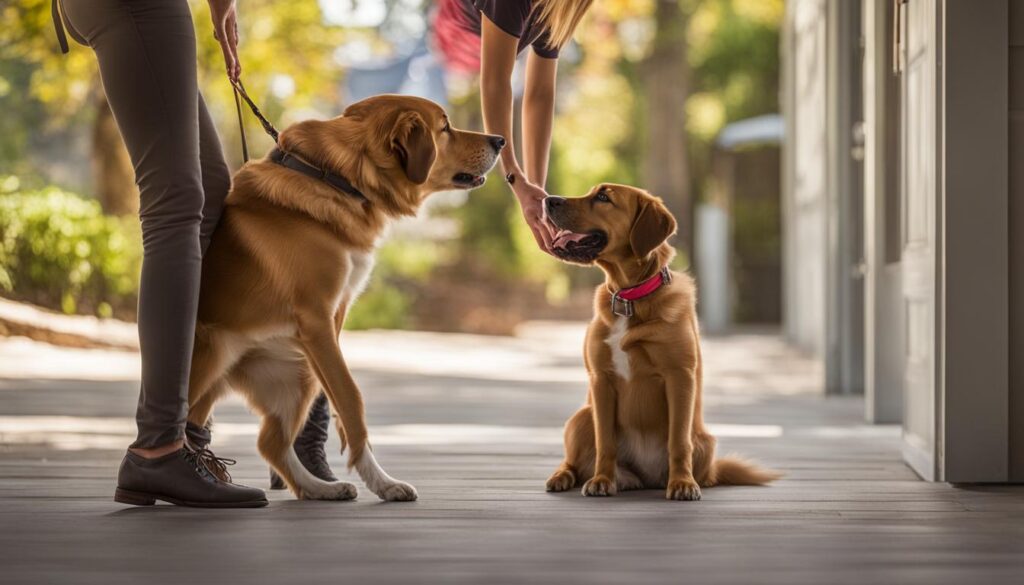
Training Session Example:
- Begin the training session in an area where jumping is likely to occur, such as by the front door or when greeting visitors.
- Hold both hands upright with palms toward the dog as the hand signal for sitting.
- When the dog jumps, turn your back and withhold attention. Avoid any verbal or physical punishment.
- Once the dog has all four paws on the ground, use the hand signal and command “sit.”
- When the dog sits, immediately reward them with a treat and verbal praise.
- Repeat this process consistently, gradually reducing the reliance on treats and reinforcing the association between the hand signal and sitting.
By following this counter conditioning technique and hand signal training, you can effectively prevent jumping in dogs and establish polite greeting behavior. Remember to be patient, consistent, and always use positive reinforcement. With time and practice, your dog will learn to greet people calmly and keep all four paws on the ground.
Overcoming Challenges and Maintaining Consistency
Training dogs not to jump requires patience, consistency, and overcoming various challenges that may arise during the process. Practicing in different scenarios and involving friends and family can help reinforce training exercises to reduce jumping behavior. It’s important to remember that dogs learn through repetition and reinforcement, so maintaining consistency is key to success.
One challenge you may encounter is the dog’s excitement level. Dogs are more likely to jump when they are highly excited, such as when guests arrive or during playtime. In such situations, it can be helpful to redirect their energy and attention towards an alternative behavior. For example, you can ask them to sit or perform a trick before giving them attention or rewarding them.
Another challenge is when the dog jumps on unfamiliar people or children. It’s crucial to teach the dog appropriate behavior around all individuals. One effective approach is to gradually introduce the dog to different people, starting with calm and familiar individuals, and gradually progressing to more challenging situations. Consistently reinforcing the training exercises and using positive reinforcement techniques, such as treats and praise, can help the dog learn to greet people politely without jumping.
Common Challenges and Solutions:
- The dog jumps on guests: Encourage guests to ignore the dog until they are calm and sitting. Reward the dog for calm behavior.
- The dog jumps when excited: Redirect their energy by asking them to perform a specific command or engage in an alternative behavior before giving them attention.
- The dog jumps on unfamiliar individuals: Gradually introduce the dog to different people, starting with calm and familiar individuals, and reward them for appropriate greetings.
- Inconsistency in training: Ensure that everyone interacting with the dog follows the same training techniques and rewards desired behavior consistently.
By addressing these challenges and maintaining consistency in your training approach, you can successfully teach your dog not to jump on people. Remember to be patient, provide positive reinforcement, and celebrate their progress along the way. With time and dedication, your dog will learn to greet people politely with all four paws on the ground.
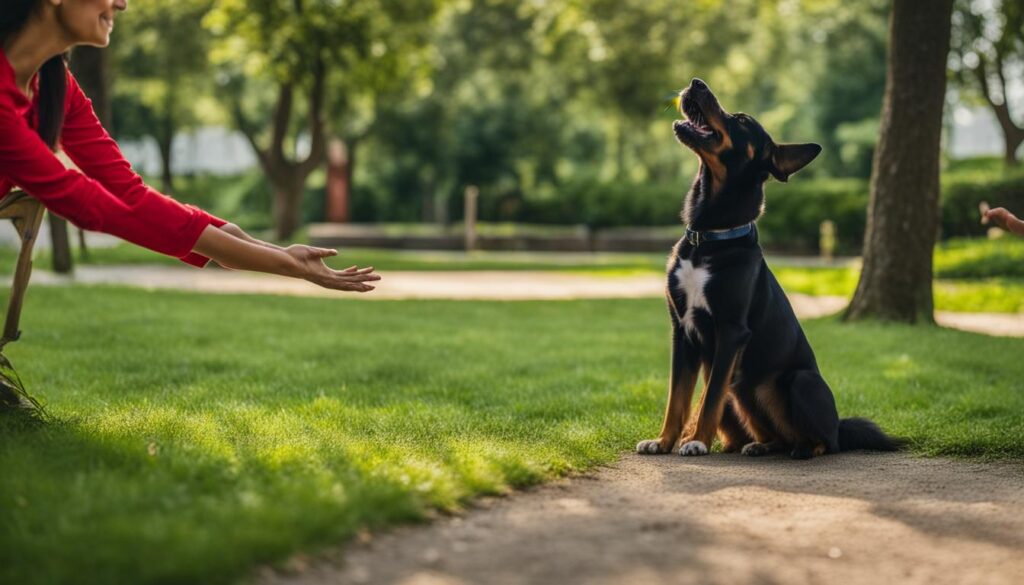
Tips for Maintaining Consistency:
- Have a designated training routine: Set aside specific times each day for training sessions to establish a consistent training schedule.
- Involve the entire family: Ensure that everyone in the household follows the same training techniques and reinforces consistent behavior.
- Use visual cues: Introduce a specific hand signal or command that signifies the desired behavior, such as a raised palm to indicate a sit command.
- Keep treats readily available: Use treats as rewards for desired behavior, and always have them on hand during training sessions.
- Stay patient and persistent: Consistency is key, but it may take time for your dog to fully understand and consistently exhibit the desired behavior.
| Challenge | Solution |
|---|---|
| The dog jumps on guests | Encourage guests to ignore the dog until they are calm and sitting. Reward the dog for calm behavior. |
| The dog jumps when excited | Redirect their energy by asking them to perform a specific command or engage in an alternative behavior before giving them attention. |
| The dog jumps on unfamiliar individuals | Gradually introduce the dog to different people, starting with calm and familiar individuals, and reward them for appropriate greetings. |
| Inconsistency in training | Ensure that everyone interacting with the dog follows the same training techniques and rewards desired behavior consistently. |
Conclusion
Managing and training jumping behavior in dogs is essential, especially in large dog breeds. By using positive reinforcement techniques and maintaining consistency, you can effectively curb this behavior and ensure a polite greeting from your furry friend.
Understanding why dogs jump is the first step in addressing this behavior. Dogs often jump up to seek attention, and any type of attention can be perceived as a reward. By withholding attention when your dog jumps up and rewarding them when they keep all four paws on the ground, you can reinforce the desired behavior.
Implementing counter conditioning techniques is another effective method. Teach your dog to sit on command and provide treats as rewards when they choose to sit instead of jumping. Additionally, introducing a new hand signal, such as holding both hands upright with palms toward the dog, can further reinforce the sit command and discourage jumping.
Remember, it is crucial to avoid punishment and outdated methods. Punishment can harm your dog and erode the trust between you and your furry companion. Instead, focus on positive reinforcement, involve others in the training process, and maintain consistency. With patience and persistence, your dog can learn to greet people politely and keep all four paws on the ground, ensuring a harmonious and enjoyable interaction for everyone.
FAQ
Why do dogs jump up?
Dogs often jump up to seek attention and greet people.
Why is jumping behavior a problem in dogs?
Jumping behavior in dogs can be dangerous and bothersome, potentially causing injury to people and damage to property.
How can I train my dog not to jump?
Positive reinforcement techniques, such as withholding attention when the dog jumps and rewarding them when they keep all four paws on the ground, can be effective in training dogs not to jump.
Should I use punishment to stop my dog from jumping?
No, punishment is ineffective and damaging to the human-dog relationship. Positive reinforcement and consistency are key in training dogs not to jump.
Can involving friends and family in the training process help in curbing jumping behavior?
Yes, involving others in the training process can help reinforce consistent behavior and improve the dog’s response to training.
What is counter conditioning and how can it be used to prevent jumping?
Counter conditioning involves teaching dogs a behavior that competes with the unwanted behavior, in this case, jumping. One effective technique is to teach the dog to sit on command and rewarding them with treats when they sit instead of jumping.
How can a new hand signal be used to discourage jumping?
Teaching the dog a new hand signal, such as holding both hands upright with palms toward the dog, can reinforce the sit command and help the dog associate it with sitting instead of jumping.
What challenges can arise in training dogs not to jump?
Dogs may exhibit jumping behavior in various situations, so it is important to practice in different scenarios. Maintaining consistency in training and using treats as rewards can help overcome these challenges.
How long does it usually take to train a dog not to jump?
The time it takes to train a dog not to jump can vary depending on the dog’s individual temperament and previous training. Consistency and persistence are key in achieving success.


